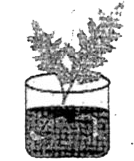Take a plant stem and with the help of your teacher cut into very thin silces or sections.
Now, stain the slices with safranin. Place one neatly cut section on a slide and put a drop of glycerine.
Cover with a slip and observe under a microscope. Observe the various types of cells and their arrangement. Are all cells similar in structure ?
No. All the cells are not similar in structure.
Topper's Solved these Questions
- TISSUESBOOK - KUMAR PRAKASHANCHAPTER - TISSUESEXERCISE - NEXT QUESTIONS AND ANSWERS
10 Videos
- TISSUESBOOK - KUMAR PRAKASHANCHAPTER - TISSUESEXERCISE - QUESTIONS AND ANSWERS (ANSWER THE FOLLOWING QUESTIONS IN VERY SHORT : (1 MARK EACH)
12 Videos
- THE FUNDAMENTAL UNIT OF LIFEBOOK - KUMAR PRAKASHANCHAPTER - THE FUNDAMENTAL UNIT OF LIFEEXERCISE - QUESTIONS AND ANSWERS ( Fill in the blanks by selecting the correct alternative from those given in the bracket : )
24 Videos
- WHY DO WE FALL ILLBOOK - KUMAR PRAKASHANCHAPTER - WHY DO WE FALL ILLEXERCISE - Value based Questions with Answers
4 Videos
Similar Questions
Cut a transverse section of young stem of a plant from your school garden and observe it under the microscope. How would you ascertain whether it is a monocot stem or dicot stem? Give reasons.
View SolutionCut a transverse section of young stem of a plant from your school garden and observe it under the microscope. How would you ascertain whether it is a monocot stem or dicot stem? Give reasons.
View Solution
Knowledge Check
A plant stem was cut and kept in a red colored solution for approximately one hour. Following this, a thin transverse section was sliced from the plant stem and was observed under a microscope. Few tissues of the sliced section showed red color while others did not.

Which tissue showed red color under the microscope?AMeristemBCorkCXylemDPhloemRam wanted to see the internal structure of a plant stem. He took the transfer section of the stem and observed under the microscope. He saw a number of cells arranged in 3-4 layers of parenchyma cells, followed by pericycle. To which tissue system do these parts belong to?
AVascular tissue systemBGround tissue systemCEpidermal tissue systemDMeristematic tissueA group of PUC students are appearing for a biology practical examination. One of the practical problems is to identify the slide focused under a microscope. When they observe, they see a structure more or less spherical having an outer most layer which is green in colour and in the middle many of parenchyma cells and a number of skull-shaped bundles are arranged irregularly all around. Help them in identifying the structure properly.
AIt is the transfer section of a dicot stem.BIt is the transfer section of a monocot root.CIt is the transfer section of a di cot leaf.DIt is the transfer section of a monocot stem.
Cut a transverse section of young stem of a plant from your school garden and observe it under the microscope. How would you ascertain whether it is a monocot stem or a dicot stem ? Give reasons.
View SolutionActivity 1: Take a conical flask and collect the water in it from a pond having stagnent water and aquatic plants. Add some wheat grans and aquatic plants to it. Keep it for 3-4 days so that wheat grains and plants will decompose. Early in the morning on fourth day, take a glass slide and put a drop of that water over it. Carefully, put a cover-slip on that drop and observe under compound microscope.
View SolutionActivity 1: Take a conical flask and collect the water in it from a pond having stagnent water and aquatic plants. Add some wheat grans and aquatic plants to it. Keep it for 3-4 days so that wheat grains and plants will decompose. Early in the morning on fourth day, take a glass slide and put a drop of that water over it. Carefully, put a cover-slip on that drop and observe under compound microscope.
View SolutionRead the following statements regarding the various techniques used in cancer detection.
(i) Cancer detection is based on biopsy and histopathological studies of the tissue, and blood and bone marrow tests for increased cell counts in case of leukaemia.
(ii) In biopsy, a piece of the suspected tissue cut into thin sections is stained and examined under microscope by a pathologist.
(iii) Techniques like radiography (use of X-rays), CT (computed tomography) and MRI(magnetic resonacne imaging) are very useful to detect cancers of the internal organs.
(iv) Computed tomography uses strong magnetic fileds and non-ionising radiations to detect physiological changes in living tissues.
(v) MRI uses X-rays and ionising radiation to generate a 3-D image of the internal structure of an object.
Which of the above statements are incorrect ?
View SolutionRead the following statements regarding the various techniques used in cancer detection.
(i) Cancer detection is based on biopsy and histopathological studies of the tissue, and blood and bone marrow tests for increased cell counts in case of leukaemia.
(ii) In biopsy, a piece of the suspected tissue cut into thin sections is stained and examined under microscope by a pathologist.
(iii) Techniques like radiography (use of X-rays), CT (computed tomography) and MRI(magnetic resonance imaging) are very useful to detect cancers of the internal organs.
(iv) Computed tomography uses strong magnetic fileds and non-ionising radiations to detect physiological changes in living tissues.
(v) MRI uses X-rays and ionising radiation to generate a 3-D image of the internal structure of an object.
Which of the above statements are incorrect ?
View Solution
